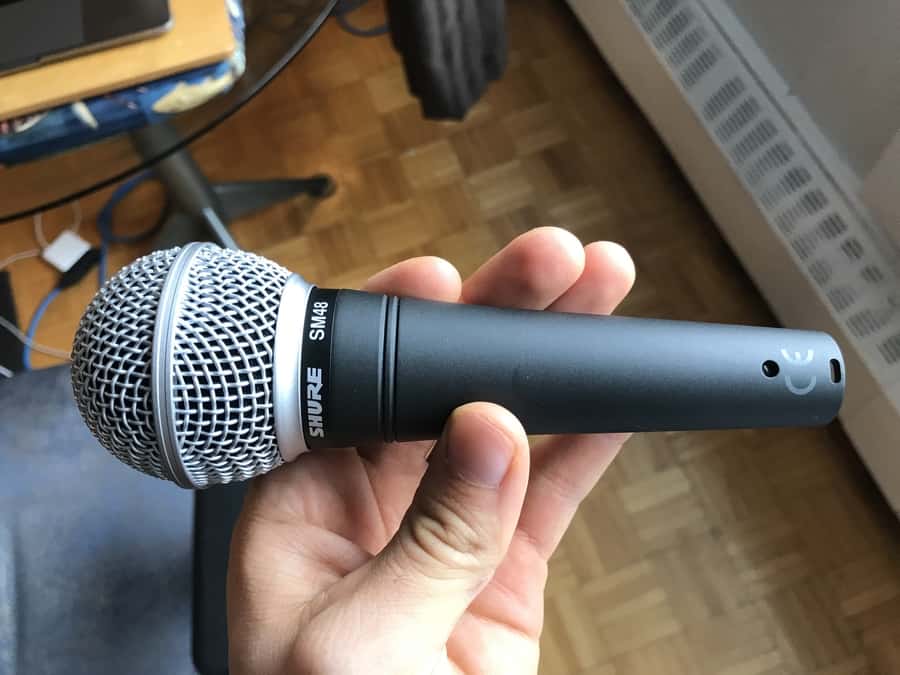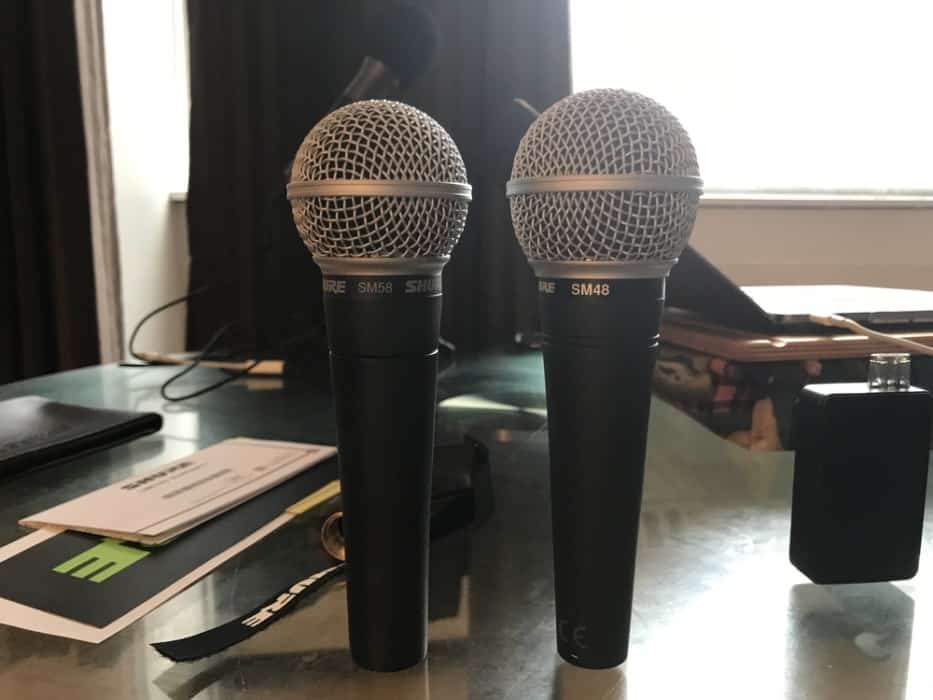As an Amazon Associate, I earn from qualifying purchases. Additionally, I earn a commission through each purchase made on Amazon, Clickbank, zZounds, Plugin Boutique, Plugin Fox, Thomann, Jam Play, and Punkademic from one of my links.
If you’re looking for an inexpensive entry-level microphone for recording vocals, I would suggest grabbing the Shure SM48 Microphone.
The Shure SM48 is easily the best CHEAP microphone for someone who’s just starting out in music production and recording.
You can check out the price of the mic on Amazon at this link here.
While I would suggest grabbing the Audio Technica 2035 if you’re looking to get more serious about recording vocals, the Shure SM48 is a great introduction to the world of microphones.
From what I understand, Shure has several different series of microphones at different levels of quality, including the PGA, SV, and the PA series, in addition to the SM series.
The SM series is supposed to be higher quality and they’re commonly a bit more expensive. The SM48 is kind of like the cheaper version of Shure’s industry staple, the SM58.
Oddly enough, however, this microphone is actually much cheaper than a few of the models from some of the other series, so it’s hard to say what the actual purpose of their model series is.
Regardless of semantics, the Shure SM48 is a fantastic mic for those of us who are on a budget.

What Comes In The Box
- Microphone – Obviously.
- Microphone Clip
- Zippered storage bag
- Documentation
- Velcro Cable Tie
- A sticker

Frankly, Shure could learn a thing or two from Samson when it comes to included products.
However, I imagine the lack of tripod, foam guard, and XLR cable is what allows Shure to make a better microphone – there are less bells and whistles, so to speak.
Features
- The cardioid polar pattern does a good job of eliminating sounds and feedback.
- It has the shock-mounted cartridge which is sufficient for reducing handling noise
- The build quality is solid and it’s quite rugged
- The mid-range is solid, although not as good as the SM58, and there is a good bass roll-off.
It doesn’t include an on-and-off switch.
Design
There really isn’t much to talk about when it comes to the design of the Shure SM48, because everybody in the audio and music world knows the design of Shure products.
It has the instantly recognizable look to the mic that nearly every bar, venue, church, or concert hall has in their possession.
It has the hard, steel, grey body with the steel grill, and it’s as every bit as solid as the Shure SM58.

The similarity between the SM58 and the SM48 makes the two products practically indistinguishable, with the exception of the fact that the Shure SM48 has a slightly larger grill.
In fact, I wouldn’t be surprised that if you switched the labels on them, most people wouldn’t even be able to tell the difference.
You can check out the comparison image below:

Build Quality
The Shure SM48 is very similar in its construction to the Shure SM58. In fact, the two microphones are nearly identical and they look exactly the same.
Because it’s from Shure, the build quality is stellar, and it’s definitely not the type of microphone that’s going to break you if you drop it a few times.
You could probably get away with dropping it several dozen times over the next few years.
Like other Shure microphones, it’s mostly constructed out of metal, which is a huge plus, in my opinion. It’s got the metal mesh grill on the top of the unit to protect the most important components.
As I mentioned above, the construction of the Shure SM48 is nearly the same as the Shure SM58 and it’s fairly heavy. It probably weighs around 370 grams.
There’s no question that this microphone is going to last you a long time, probably even a decade or more if you take care of it and don’t drop it a million times.
Even if you did drop it over and over again, it would probably still work.
List of Shure SM48 Specifications
- Dynamic Microphone
- Cardioid Polar Pattern (coming from the front)
- Frequency Response of 55Hz to 14,000kHz
- A Sensitivity of -57.5 dB
- Impedance of 150ohms
- Connector: Three-Prong Audio (XLR Male)
- Output Level: -57.5 dB/Pa (1.3 mV)
- Housing: Plastic with Steel Grill
- Weight: 370 grams or 0.82 pounds
- Size: Length – 166mm x Width – 54.2mm
How It Sounds
If you want to know the truth of this microphone, the sound quality is fairly comparable to the Shure SM58. Most people won’t even know the difference and won’t care either.
Is this the best microphone for recording vocals?
No, but if you’re on a budget, it’s going to be a great choice for you. Moreover, the sound quality of it, during a live performance, for example, is going to perform well enough that nobody will ever care or notice.
In other words, if you need a cheap microphone for your set-up, bar, venue, etc, this is a great budget option and you won’t be disappointed with it, especially considering it’s around half the price of a Shure SM58.
It also does a fairly good job of isolating certain sounds on account of the cardioid polar pattern.
For instance, if you’re typing on your keyboard while recording vocals at the same time – like if you’re podcasting – it’s more than capable of isolating the sound of your voice without highlighting the sounds of noisy keys.
Furthermore, it’s going to sound just fine for recording acoustic guitar or other instruments.
The clarity of this microphone is top-notch as well, so it’s certainly not lacking in this area.
It has a fairly large boost in the treble frequencies. Although, it’s worth noting that it does start to roll off around 10,000kHz.
Regarding plosive sounds like the “p” sounds or “s,” this mic isn’t the best but it does a good enough job, especially if you’ve invested in a pop filter to really get rid of those intrusive sounds.
When it comes to handling noise (handing the microphone to and from another person or even just moving it around), I would argue that it does the job well.
In summary, I would say the SM58 has slightly better sound than the SM48, but the difference will be lost on most listeners and users.
When comparing it to the Samson Q2U, the SM48 is definitely a better microphone in terms of audio quality and in build quality.
Differences Between The Shure SM48 and The Shure SM58
1) One of the primary differences between this microphone and the SM58 is the fact that the SM58 has much cleaner mid-range frequencies. For that reason, the SM58 will probably do better when it comes to recording vocals that cut through the mix.
2) There needs to be a post-production phase with the Shure SM48 as well, including a compressor, EQ, and so on. Although, it’s usually best to use dynamics processors to increase the quality anyway.
3) The Shure SM48 doesn’t have as wide of a frequency range. The frequency range of the SM48 is 55Hz to 14,000kHz, whereas the SM58 has a frequency range between 50Hz and 15,000kHz.
4) And lastly, the Shure SM48 is much cheaper than the SM58. It’s around 60% less expensive.
5) The grill on the Shure SM48 appears to be a little bit bigger than the Shure SM58, but it’s hardly noticeable.
Important Things to Note
In my opinion, you need to boost the gain on your audio interface when using either of these microphones.
For instance, in my article on the SM58, I said it was a good idea to increase the gain by around +7dB.
How To Set Up The Shure SM48
Similar to the SM58, you’re going to need an audio interface to get the SM48 to work.
This isn’t a USB microphone, like the Samson Q2U which hooks up directly into one’s computer.
1) Plug your adaptor into your MacBook Pro (assuming you have a new model).
2) Run the USB to Firewire cable from the audio interface into the adaptor.
3) Using an XLR cable, hook up the cable to the input of your audio interface and run it into your SM48.
4) In Garageband’s Preferences, switch the “Input” setting to your audio interface.

You can see how easy it is to set this thing up in the image below:

YouTube Video Review
Conclusion
This is definitely a great option for someone looking to get a quality microphone for a cheap price, and it’s going to work just fine for pretty much any purpose, however, the Shure SM58 and SM48 are best for live performances.
Taking everything into account, the Shure SM48 is probably the best option in terms of the total value.
You have to ask yourself whether it’s worth it or not to spend around 60% more just for a slight increase in quality.
For me, I would say it’s best to go all out and get a superior microphone, but this is a great option if you want to spend less money and still get nearly the same value.
With that said, if you’re looking for a better microphone but in the same vein as this one, check out my article on what I think is the best microphone for beginners to get. It’s at this link here.

 Written By :
Written By :